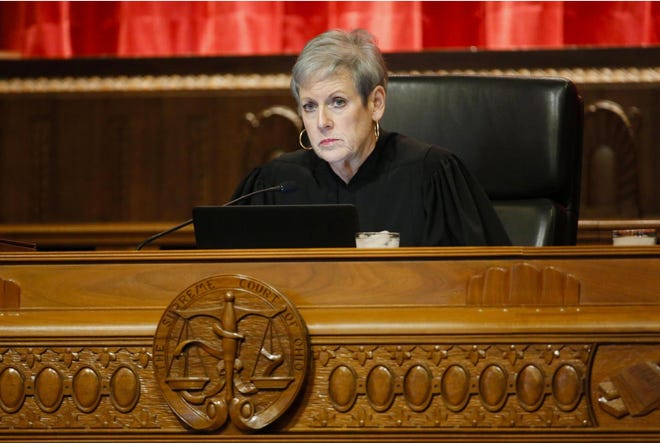

Supreme Court Chief Justice Justice Maureen O'Connor might be the most important person in Ohio politics right now.
O'Connor will preside over lawsuits challenging Ohio's congressional and statehouse maps – key tests of whether voter-approved changes to the state Constitution will prevent maps that favor the political party in power: Republicans.
O'Connor, a Republican, is viewed as an independent voice on a court that is divided between four Republicans and three Democrats. She wanted to strike down 2011 statehouse maps drawn to favor Republicans, dissenting from the majority's decision that upheld them in 2012.
On Wednesday, lawyers will lay out their cases for and against state House and Senate maps drawn by the seven-member Ohio Redistricting Commission that could allow Republicans to retain their veto-proof majorities.
Redistricting in Ohio:'A flagrant violation of the Ohio Constitution:' Lawsuit challenges 4-year Statehouse maps
When they do, all eyes will be on O'Connor.
Here's why: O'Connor has fought for the independence of judges, opposing party labels for judicial candidates even though the change would likely help GOP candidates in an increasingly red state. As the chief justice, O'Connor has also championed transparency and fairness – collecting data on criminal sentences and racial biases to inform future decisions.
Her message appears to be: "Keep your broken politics out of our court system," said David Pepper, former chairman of the Ohio Democratic Party.
Before her election to the top court in 2002, O'Connor served as lieutenant governor to Republican Gov. Bob Taft. But she is also willing to call out her own party, calling the Ohio Republican Party's statement about a Democratic judge's drop box decision “a blatant and unfounded attack on the independence of the Ohio judiciary.”
O'Connor, 70, is also leaving at the end of 2022, unable to run for reelection because of age limits on Ohio Supreme Court justices set in 1973. Attempts to raise the age limit from 70 years old to 75 have failed, even though other politicians don't face the same restrictions. Gov. Mike DeWine, for example, is 74 years old.
When she ends her career, O'Connor will have held statewide elected office longer than any woman in Ohio history.
Fairness in sentencing:Can a spreadsheet improve fairness and justice in sentencing in Ohio courts? Some judges say yes
What happened in the 2012 maps case?

O'Connor has been here before. She is the only member of the current Ohio Supreme Court who heard legal arguments over maps drawn in 2011.
In 2012, O'Connor questioned Republican attorney Mark Braden, who was defending the maps, about why the state House and Senate maps split so many communities when other proposals had far fewer.
“When you start with the premise that counties are to remain whole if at all possible, and we see a plan that will split 50 counties, and we see a plan that will do only 30, how are we to then say, 'Well, the 50 county-plan, splitting 50 counties is better or is constitutional?'” O'Connor asked.
In the years since those maps were upheld against O'Connor's wishes, Ohio voters have approved more changes to the state Constitution aimed at reducing partisan gerrymandering – the favoring of one political party over the other.
That didn't stop five Republicans on the Ohio Redistricting Commission from approving maps that would allow the GOP to keep its veto-proof majorities.
Democrats and voting rights groups say that advantage violates the Ohio Constitution's requirement that mapmakers attempt to draw districts that align with statewide voting preferences. Over the past decade, Republican candidates have won 54% of the vote and Democratic ones have won 46%, on average.
A push for a different court
The Ohio Supreme Court didn't always have this political balance. In early 2018, Republicans held every seat on the Ohio Supreme Court. The sole Democrat, Bill O'Neill, had just launched a gubernatorial bid, which ultimately failed.
Democrats, knowing the Ohio Supreme Court's key role in checking gerrymandered maps, wanted more seats on the high court. They picked up two seats in 2018: Justices Melody Stewart and Michael Donnelly; and another in 2020: Justice Jennifer Brunner.
Ohio Supreme Court:Jennifer Brunner ousts Judith French to narrow GOP majority to 4-3
Both parties emphasized redistricting in a heated race between Brunner and Republican incumbent Judi French. Republican operative Karl Rove wrote a fundraising letter for French, saying money was needed to prevent lines drawn to benefit "liberal Democrats."
The Ohio Republican Party has called on Brunner to recuse herself from the redistricting case, even launching ads about what they call her conflict of interest. She has refused, as has Republican Justice Pat DeWine, even though his father is one of five Republicans who approved the maps.
Ohio Su:Justice Pat DeWine won't recuse himself from lawsuits over maps approved by father Gov. Mike DeWine
"Winning those three seats was a critical part of establishing the kind of court that will protect the Constitution and not the politicians at the statehouse," said Pepper, adding that doesn't mean a certain outcome is assured. "I don’t think any lawyer is walking into that court case knowing they are going to win, and that’s how it’s supposed to work."
Jessie Balmert is a reporter for the USA TODAY Network Ohio Bureau, which serves the Akron Beacon Journal, Cincinnati Enquirer, Columbus Dispatch and 18 other affiliated news organizations across Ohio.
Source link








